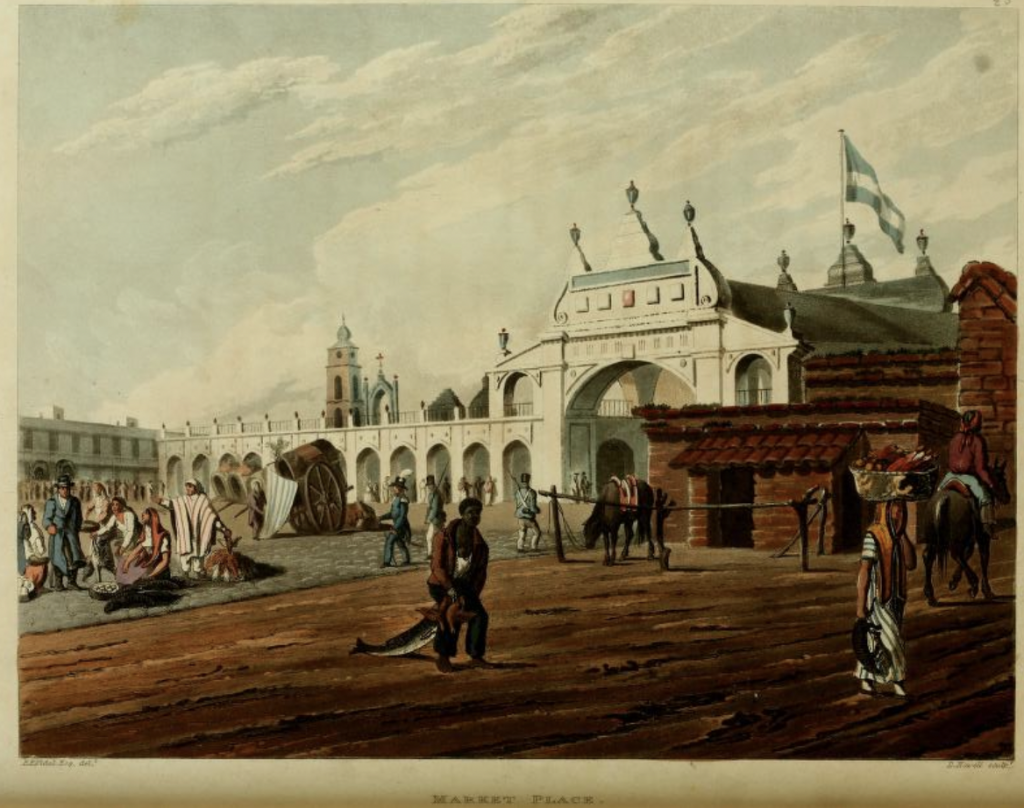
Emeric Essex Vidal was a British painter, a watercolorist who traveled through Argentina and Uruguay, painting scenes of the city and countryside. He also served in the British Navy, which allowed him to travel extensively through Latin America. His Travelogue, 24 Picturesque Illustrations of Buenos Ayres and Montevideo, explores many scenes of Buenos Aires and the surrounding Pampas, with commentary on race, gender, and the economy, along with slavery and industry.
The Author displays a positive view of the racial hierarchy, and argues that the hierarchy is good and those at the bottom support it. For example, Vidal describes the institution of slavery as beneficial, and even that the slaves were happy in that he argues “I have seen many of them refuse liberty when offered to them”(Vidal, 31).By this he means slaves who are given the option to be free refuse it. He takes on a similar viewpoint to many in the Antebellum South when discussing slavery, in that slaves are both treated well and liked being slaves. Vidal is also careful to mention that the treatment of slaves is good, and arguably better than in some of the British colonies. He points out that the treatment of slaves is “highly honorable to the Spanish character”(Vidal, 30). In this way he links the institution of slavery to the Spanish colonial legacy, that it is only beneficial because of the European influence.
The previous example from the excerpt on slavery reflects the British policies on slavery at the time– as Vidal’s Travelogue was published in 1820, the 1807 Slave Trade Abolition Act had already been passed(Anstey, 317) which ended Britains direct involvement in the Transatlantic slave trade, but it would be another thirteen years before slavery in British colonies would be abolished. This places Vidal in a tricky situation, since he cannot sit fully on the moral high ground and blame Latin American backwardness for slavery as his nation still practices it as well. His travelogue, in its detailed accounts of resources, from fruit to livestock, shows how many may view Latin America as a potential for investment, but the characterization of how the butcheries are unclean (Vidal, 36) and how “To a European, however, the most remarkable of the mendicant fraternity in these streets is a beggar on horseback”(Vidal, 51) show how Europeans view Latin American customs as backwards, or at least unintelligible, without accounting for local context.
Sources:
Anstey, Roger. “A Re-Interpretation of the Abolition of the British Slave Trade, 1806-1807.” The English Historical Review 87, no. 343 (1972): 304–32. http://www.jstor.org/stable/563288.
Vidal, Emeric Essex. Picturesque Illustrations of Buenos Ayres and Montevideo, Consisting of 24 Views: Accompanied with Descriptions of the Scenery, and of the Costumes, Manners &c. of the Inhabitants of Those Cities and Their Environs. London, UK: R. Ackermann, 101 Strand, 1820. https://archive.org/details/picturesqueillus00vida/page/n7/mode/2up?ref=ol&view=theater
By Gavin Neff
